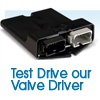Daniel Bernoulli – this 18th century Swiss mathematician – has left quite the impact on the modern fluid power industry. One of his more popular discoveries is known as the Bernoulli Principle. This principle states that an increase in a fluid's speed decreases its pressure. If this is true, and we know it is, then the opposite must also be true: that a decrease in a fluid's speed increases its pressure. This principle applies to both the lifting of a wing on an airplane, as well as the lifting of a cartridge valve poppet. |
 |
So what exactly does this have to do with HydraForce and cartridge valves in general? I'm glad you asked. In the cartridge valve world, we are primarily concerned with Bernoulli Flow Forces. Since we have hydraulic oil (fluid) moving through the cartridge valves at some speed, we must have some sort of pressure associated with that fluid at a given speed. Designing valves to use these flow forces to our advantage has been a critical piece of cartridge valve development and manifold design.
However, where there are advantages, there are usually disadvantages. One such disadvantage is using port 1 as an inlet port for solenoid operated three, four and five way, spool-type cartridge valves. Although most of you reading this can probably read and understand hydraulic symbols, paying close attention to the arrows of flow in those symbols is something you need to watch. For example: You may notice that several of our solenoid spool valve symbols have work port arrows from 2, 3, or 4 to port 1 (the bottom port or nose of the valve) but rarely do you see the arrow indicating oil flow from port 1 to these work ports. Thanks Bernoulli!!
Basically what happens is that flow coming into port 1 hits the bottom of the spool and these flow forces can potentially “self shift” the solenoid valve. The spring used to keep the valve in its normal state is very carefully balanced with a number of factors, such as magnetic force needed to energize the valve, the power required to create that magnetic field (which relates to Ohm’s Law) the air gap in the actuator, and the actual flow and pressure ratings of the valve. If the spring is too heavy the valve will not energize, if the spring is too weak the flow forces acting on port 1 can potentially shift the spool valve without energizing it. In addition, a normally open spool valve that is being over-flowed may not energize to close because of these flow forces. The same is true for a normally closed valve attempting to shift back (dropout) to its closed position.
So, why tell you all this? As a general rule, for those of you specifying solenoid operated spool type cartridge valves and designing systems, port 1 or the nose of the valve should be designed as an outlet or tank port only. Using port 1 as an outlet or tank port when designing your system will help eliminate potential self-shifting of solenoid spool valves due to over flow or over pressure situations.
We all know that no one ever pushes the limits of their hydraulic components...right? So, this really should be a non-issue, but for those of you who may push the envelope, why not design out this failure from the start? If you feel you have to go against this recommendation and use port 1 as in inlet, please consult us here at the factory for assistance.
Up until now, I have been referring to solenoid-operated direct-acting spool valves and the flow force disadvantage on these types of valves. So what about the solenoid-operated poppet valves? Here we actually need these flow forces to “lift” the main poppet to allow or block flow. In a pilot operated (two-stage) poppet valve these flow forces are required to move (lift) the main poppet (second stage). Because these poppet valves are a 2-stage design, energizing and de-energizing these valves moves a small pilot pin (stage 1) and then Bernoulli forces, along with some help from Pascal, open and close the main poppet (stage 2). Thanks again Bernoulli. Based on this information, pushing the envelope of rated flow on a solenoid poppet valve would be the better choice.
In Summary:
Bernoulli Disadvantage:
Solenoid Operated Spool Valves: Design your systems to have port 1 (the nose of the valve) as outlet ports. Do not push the rated flow limit. Stick to catalog ratings.
Bernoulli Advantage:
Solenoid Operated Poppet Valves (two-stage): Can be over-flowed, but watch your pressure drop. If you need to push the envelope in terms of flow and can live with the added pressure drop, use a pilot-operated, poppet-style valve.
So, Daniel Bernoulli – Thanks…I guess!
For a much more in depth explanation of solenoid cartridge valve construction and operation, see our solenoid training school on the HydraForce website.
About the Author:
Lisa DeBenedetto is a Regional Manager at HydraForce with more than 20 years of
hydraulic experience. She has been with HydraForce for over 16 years. Contact Lisa







